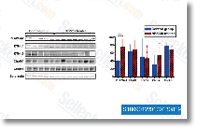In xenograft samples of glioblastoma, grown inside the brains of nude mice, we observed enhanced expression of miR 143 and miR 145 on either side with the tumor host brain interface. Even though a common basement membrane matrix hasn’t been described on the interface amongst xenograft tumor and host brain, reactive astrocytes, along with the invading tumor itself can the two secrete ECM parts shared by the Matrigel substrate. Our collection of cells capable of invading through Matrigel may have identified these with cellular machinery permitting development and invasion along the Virchow Robin space and also the brain tumor interface. In situ regional expression of our target microRNAs in tumor samples illustrates, as soon as once again, the regional heterogeneity of glioblastoma, and supports our hypothesis about their part in mediating invasion.
Synergistic anti invasive effect of knocking down both of miR 143 and miR 145 Within a series of transient transfection experiments, we have shown that antisense microRNAs therapy knocking down miR 143 and miR 145, in combination, abrogates the invasive phenotype of every of our human glioma cell lines. straight from the source Interestingly, during the U87 cell line, miR 145 knockdown alone was ample to provide a reduction in invasive phenotype, whereas in other cell lines, the mixed remedy was wanted to determine the identical impact. This getting underscores the necessity to characterize the expression of potential downstream tar will get across various human glioblastoma lines and main cultures, and also to locate those characteristic distinctions involving lines that account for the inconsistencies. Extra importantly, VX222 VCH222 this factors towards a molecular synergy that’s not still defined.
Probable targets of miR 143miR 145 and potential directions In an hard work to characterize  the crucial downstream tar gets of miR 143 and miR 145, we utilized 3 algorithms to score the probability of every to hybridize to, and influence translation of, unique genes. The on line search algo rithms TargetScan, PicTar, and MicroCosm were all made use of to stratify targets. By filtering the resulting lists for anyone targets that have been identified by multiple search algorithms, we located various prospective miR 145 targets within the SlitRobo pathway, which was lately recognized as an inhibitor of brain tumor cellular migration and invasion. In western blot experi ments, we acknowledged a decreased expression of srGAP1 in the invasive subpopulation of U87 cells. More defini tion from the part of srGAP1 exercise, coupled with clearer comprehending of other downstream mediators of each miR 143 and miR 145 is necessary. The partnership among miR 143miR 145 expression and also other identified mediators of glioma invasion must be defined. Extremely lately, Yan et al.
the crucial downstream tar gets of miR 143 and miR 145, we utilized 3 algorithms to score the probability of every to hybridize to, and influence translation of, unique genes. The on line search algo rithms TargetScan, PicTar, and MicroCosm were all made use of to stratify targets. By filtering the resulting lists for anyone targets that have been identified by multiple search algorithms, we located various prospective miR 145 targets within the SlitRobo pathway, which was lately recognized as an inhibitor of brain tumor cellular migration and invasion. In western blot experi ments, we acknowledged a decreased expression of srGAP1 in the invasive subpopulation of U87 cells. More defini tion from the part of srGAP1 exercise, coupled with clearer comprehending of other downstream mediators of each miR 143 and miR 145 is necessary. The partnership among miR 143miR 145 expression and also other identified mediators of glioma invasion must be defined. Extremely lately, Yan et al.
Microrna Array
MiRNAs appear to target about 60% of the genes of humans and other mammals.
